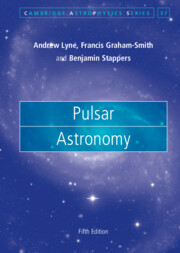Book contents
- Frontmatter
- Contents
- Preface
- Part I Discoveries and Techniques
- Part II Observed Physical Characteristics
- Part III Neutron Star Physics
- 13 Neutron Stars
- 14 Radius and Mass
- 15 Glitches, Timing Noise, Nudot Switching
- 16 Location and Geometry of Emitters
- 17 The Emission Mechanisms
- Part IV Environments and the Interstellar Medium
- References
- Index
15 - Glitches, Timing Noise, Nudot Switching
from Part III - Neutron Star Physics
Published online by Cambridge University Press: 21 July 2022
- Frontmatter
- Contents
- Preface
- Part I Discoveries and Techniques
- Part II Observed Physical Characteristics
- Part III Neutron Star Physics
- 13 Neutron Stars
- 14 Radius and Mass
- 15 Glitches, Timing Noise, Nudot Switching
- 16 Location and Geometry of Emitters
- 17 The Emission Mechanisms
- Part IV Environments and the Interstellar Medium
- References
- Index
Summary
The characteristic steps in the rotation rates of pulsars are known as glitches and arise in the irregular transfer of angular momentum from the interior to the crust as a neutron star spins down. They are related to the structure and the fluid dynamics of some superfluid components. The angular momentum is quantised in vortices, which may be pinned to the crystal structure of the crust. Glitches may be related to catastrophic unpinning events and to cracking of the crust itself. Timing noise is quasi-random variation in rotation rate. In many pulsars, the spin-down rate is seen to switch abruptly as the emission changes, indicating that changes in magnetospheric particle flows are responsible for both spin-down and radiation.
Keywords
- Type
- Chapter
- Information
- Pulsar Astronomy , pp. 235 - 257Publisher: Cambridge University PressPrint publication year: 2022

